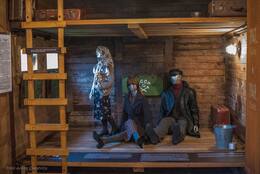1949 m. netoli Skrundos stoties slapta nufotografuotas tremties traukinys

1949 m. kovo 25 d. Skrundos mokinys Elmārs Heniņš matė, kaip buvo išvežami jo klasės draugai. Jis pasiėmė fotoaparatą ir užlipo ant netoliese esančios kalvos esančios pušys, kad užfiksuotų, kas vyksta, o vėliau nuotraukas paslėpė.
Rašytojas ir publicistas Artūras Heniņš prisimena tokį epizodą apie 1949 m. kovo įvykius:
Tačiau kambaryje stebiu šiurkštų tėvo ir jo brolio pokalbį.
− Kur buvai?
− Stotys pušynuose.
− Ko ten ieškojai?
− Nufotografavau traukinį.
− Kodėl tau reikėjo tai padaryti?
− Jie ten nusivežė mano klasės draugus Dzērvesą Herbertą ir Vilmą.
"Tu irgi norėjai, kad mus paimtų?"
Šeštos klasės mokinys įvykio vietoje Skrundos stotyje savo tėvo fotoaparatu buvo padaręs labai retą fotoreportažą, kuris iki šiol išliko laiko graužikų nudėvėtoje juostoje.
Artūrs Heniņš, Jaunā Gaita Nr.191, 1993 kovas
Susijusi laiko juosta
Susijusios temos
Susijusios vietos
Trėmimams naudotas galvijinis vagonas – muziejus Skrundos geležinkelio stotyje
1941 m. birželio ir 1949 m. kovo mėn. trėmimams atminti Skrundos geležinkelio stotyje pastatytas atminimo akmuo ir keturašis vagonas, kuris taip pat tarnauja kaip trėmimams skirtas muziejus. Tai pirmasis vagono tipo muziejus Latvijoje, kuriame nuolat eksponuojamos iš Skrundos stoties ištremtų žmonių nuotraukos, laiškai, atsiminimai, dokumentai ir įvairūs daiktai. Skrundos stotis buvo tremtinių surinkimo vieta ir viena iš trijų regiono stočių, į kurią buvo atvežti žmonės iš Skrundos ir Kuldygos apylinkių. 1941 m. iš čia į Krasnojarsko kraštą Sibire buvo ištremta pirmojo atkurtos Latvijos Respublikos prezidento Gunčio Ulmanio šeima.
Deportacijų pagalba sovietai susidorojo su nacionalinių partizanų šalininkais ir tuo pačiu metu baugino likusius kaimo gyventojus, versdami juos stoti į kolūkius.
Stendės geležinkelio stotis siaurojo geležinkelio tinkle ir atminimo akmuo tremtims
Geležinkelio linija Ventspilis–Mazirbė, taip pat Stendės–Dundagos pratęsimas iki Mazirbės su atšaka iki Pitragės buvo skirti tik strateginėms karinėms reikmėms. Šių linijų statybos metu ir vėliau iš regiono buvo evakuoti visi civiliai gyventojai. Pagrindinė karinių geležinkelių užduotis Irbės sąsiaurio rajone buvo aprūpinti Vokietijos armijos pakrantės gynybos pozicijas pabūklais ir amunicija.
Šie tik kariniams tikslams skirti kariniai geležinkeliai taip pat sujungė tris svarbiausius švyturius, esančius Ovišuose, Mikeltornyje ir Šlīterėje.
Nepaisant to, keleivių pervežimas buvo vykdomas jau Pirmojo pasaulinio karo metais.
Stendės geležinkelio stotyje yra atminimo akmuo (1989 m.) 1941 ir 1949 m. deportuotiems latviams.
1919 m. spalio 30 d. Stendės geležinkelio stotį užėmė Bermonto kariuomenė. Lapkričio 17 d. Latvijos armijos kareiviai, vadovaujami K. Šnēbergo, puolė stotį, nuvarydami vežimą su ginklais, karo medžiagomis ir grūdais. Už šiuos mūšius ordino ordinu buvo apdovanoti 6 kareiviai: K. Bumovskis (1891–1976), P. Strautiņš (1883–1969), R. Plotnieks (1891–1965), E. Jansons (1894–1977).






